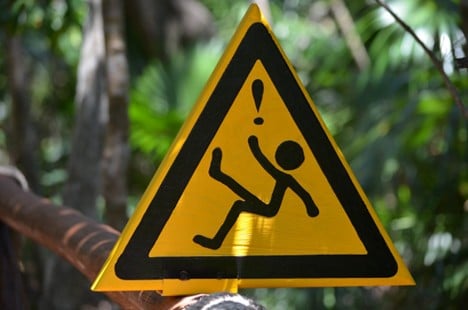Personal injury accidents can happen when we least expect them, and one of the most common yet often underestimated causes is a slip and fall on public staircases. Whether it’s a slick floor, poor lighting, or uneven steps, these seemingly minor hazards can lead to severe injuries that demand both immediate medical care and legal attention.
In fact, the World Health Organization (WHO) reports that over 37 million falls each year are serious enough to require medical treatment, and falls remain the second leading cause of accidental injury-related deaths globally. These statistics highlight just how critical it is not to dismiss a fall as a simple mishap.
If you’ve recently slipped and fallen on a public staircase, understanding your rights and responsibilities is essential. This guide outlines the crucial steps to take after a fall, your legal options, and how to determine whether someone else may be liable for your injuries.
Why Public Staircase Falls Are Legally Complicated
Unlike private property, public staircases, such as those found in shopping centers, government buildings, apartment complexes, or transportation hubs, can involve multiple parties when determining liability. Property owners, government agencies, maintenance contractors, and even security staff may all play a role in maintaining safe premises.
The legal complexity arises from needing to prove negligence (that someone failed in their duty to maintain the property safely) and that this failure directly caused your injuries. In many cases, the law doesn’t automatically hold a property owner liable just because an accident occurred.
Step 1: Seek Immediate Medical Attention
The most crucial step, even before thinking about legal matters, is your health. Slip and fall injuries can range from minor bruises to severe trauma, such as:
- Fractured bones
- Spinal cord injuries
- Concussions or traumatic brain injuries
- Soft tissue damage
Remember, adrenaline can mask symptoms. So, even if you don’t feel hurt immediately, get evaluated by a medical professional after the fall. This also creates official documentation of your injuries, which is critical for any personal injury claim you might pursue later.
Step 2: Document the Scene Thoroughly
As soon as you’re able, gather as much evidence as possible. The goal is to create a clear picture of what happened, especially if you plan to file a personal injury lawsuit. Key steps include:
- Take photographs of the scene, especially the exact staircase, the surrounding area, lighting conditions, and any visible hazards like water, ice, or debris.
- Capture your injuries with photos as well.
- Get contact information from witnesses who saw the fall or the conditions of the staircase.
- If the property has surveillance cameras, note their locations in case you need to request footage later.
This evidence will help establish the presence of a hazard and support your claim that dangerous conditions caused your fall.
Step 3: Report the Incident
If the fall occurred in a commercial or public space, report the incident immediately to a manager, security personnel, or facility supervisor. Ask them to create an official incident report and request a copy for your records.
If you fall on government property, such as at a courthouse, post office, or train station, your report may need to follow specific protocols. In these cases, it’s wise to consult a personal injury attorney right away, as filing deadlines for government claims can be much shorter than for other types of claims.
Step 4: Determine Who May Be Liable
To pursue a personal injury claim for a staircase fall, you must establish that another party was legally responsible for the unsafe condition. This typically involves proving:
- Duty of care: The responsible party had a legal obligation to keep the staircase reasonably safe.
- Breach of duty: They failed to address or warn about a dangerous condition (e.g., broken steps, poor lighting, lack of handrails).
- Causation: This breach directly led to your fall and injuries.
- Damages: You suffered actual harm, such as medical bills, lost wages, or pain and suffering.
Liable parties can include:
- Property owners or landlords
- Maintenance companies
- Government agencies
- Building managers
In cases involving shared spaces (e.g., shopping centers or apartment buildings), liability may be split among multiple entities.
Step 5: Understand Comparative Negligence
In some jurisdictions, comparative negligence laws may apply. This means the court will consider your role in the accident. If, for example, you were looking at your phone or wearing improper footwear, your compensation could be reduced proportionally.
There are generally two types of comparative negligence:
- Pure comparative negligence: You can still recover damages even if you’re 99% at fault.
- Modified comparative negligence: You can only recover damages if you are less than 50% (or 51% in some states) at fault.
Understanding how your state applies comparative negligence can significantly affect your case’s value.
Step 6: Keep Detailed Records
Your personal injury case depends heavily on documentation. Maintain a folder with:
- Medical records and bills
- Incident reports
- Photos and witness statements
- Correspondence with insurance companies or property managers
- Notes on how the injury affects your daily life
These records serve as the foundation of your damages claim, allowing your lawyer to accurately calculate medical expenses, lost wages, future treatment needs, pain and suffering, and loss of enjoyment of life.
Step 7: Contact a Personal Injury Attorney
Public staircase falls are often more than just painful; they can be legally complex and financially draining. Hiring an experienced personal injury attorney can significantly improve your chances of receiving fair compensation.
A good attorney will:
- Conduct a thorough investigation of the incident
- Identify all liable parties
- Communicate with insurers on your behalf
- File all necessary paperwork within legal deadlines
- Represent you in settlement negotiations or court
If your fall occurred on government property, legal counsel is even more essential. Government claims usually have strict notice requirements and shorter statute of limitations, sometimes as little as 30 to 90 days to file a claim.
Step 8: Be Cautious With Insurance Companies
After a slip and fall, you may receive a call from an insurance adjuster. Their job is to minimize the payout or deny your claim. Never give a recorded statement or accept a settlement without speaking to your attorney first.
Initial settlement offers are often significantly lower than what you’re entitled to. An attorney will help you avoid these common pitfalls and protect your right to full compensation.
What If the Fall Was Partially Your Fault?
If you believe you were partly to blame for your fall (perhaps you missed a warning sign or wore unstable shoes), it doesn’t automatically invalidate your claim. Most personal injury cases take shared fault into account.
This is where a legal expert can be incredibly valuable, helping you navigate state-specific laws and negotiate a fair settlement that reflects the facts of the case.
Final Thoughts
A fall on a public staircase can have serious consequences, both physically and financially. But knowing what to do in the immediate aftermath and who may be responsible can make a significant difference in your recovery and your ability to hold negligent parties accountable.
To summarize, the most crucial steps include:
- Seeking prompt medical attention
- Gathering detailed evidence
- Reporting the incident
- Identifying potential liability
- Consulting with a qualified personal injury attorney
You don’t have to navigate the legal process alone. If you’ve experienced a slip and fall on a public staircase, take action now to protect your health, your rights, and your future.


